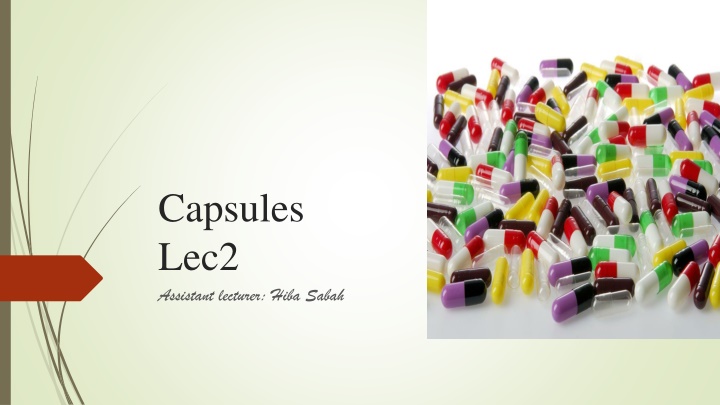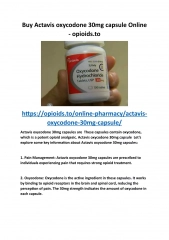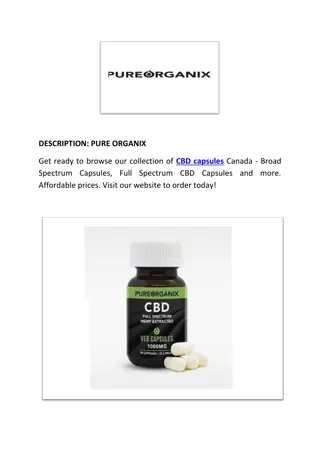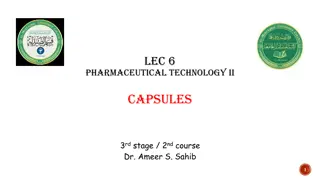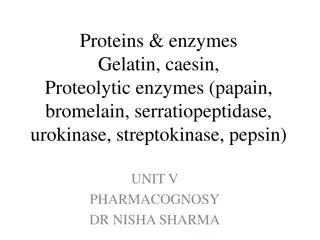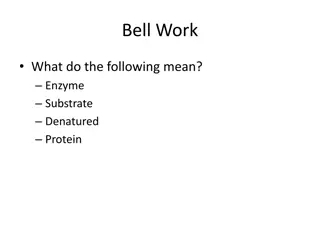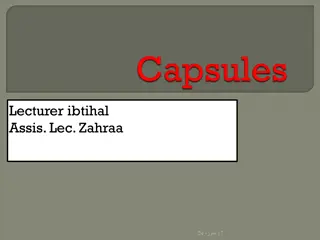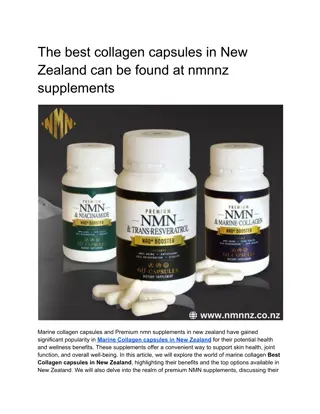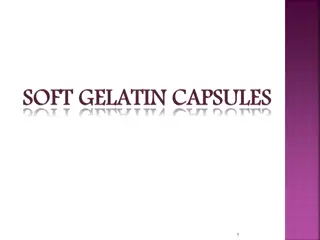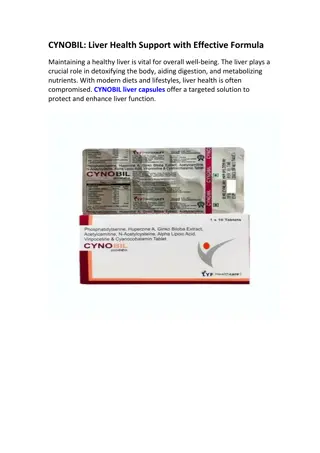Soft Gelatin Capsules: Definition, Applications, Manufacturing, and Specifications
Soft gelatin capsules are one-piece, hermetically sealed shells containing liquid, suspension, or semisolid, mainly composed of gelatin, plasticizers, and water. They are used as oral or suppository dosage forms for human/veterinary use, specialty packaging, and more. The capsules come in various shapes and sizes manufactured by methods like plate process and rotary die process. Important specifications include bloom strength, measuring the cohesive strength of the gelatin shell.
Download Presentation

Please find below an Image/Link to download the presentation.
The content on the website is provided AS IS for your information and personal use only. It may not be sold, licensed, or shared on other websites without obtaining consent from the author.If you encounter any issues during the download, it is possible that the publisher has removed the file from their server.
You are allowed to download the files provided on this website for personal or commercial use, subject to the condition that they are used lawfully. All files are the property of their respective owners.
The content on the website is provided AS IS for your information and personal use only. It may not be sold, licensed, or shared on other websites without obtaining consent from the author.
E N D
Presentation Transcript
Capsules Lec2 Assistant lecturer: Hiba Sabah
SOFT GELATIN CAPSULE Definition:- Soft gelatin capsules are one piece, hermetically sealed, soft gelatin shells containing a liquid, a suspension, or a semisolid. Soft gelatin is mainly composed of: Gelatin, plasticizers, and water in addition to preservative, coloring and opacifying agents, flavoring agents and sugars. APPLICATIONS OF SOFT GELATIN CAPSULE 1. As an oral dosage form for human or veterinary use. 2. As a suppository dosage form for rectal (pediatric and geriatric) or vaginal route. 3. As a specialty package in tube form, for human or veterinary single dose application of topical, ophthalmic and otic preparations and rectal ointments
SHAPE OF CAPSULE The shape of soft gelatin capsule are round, oval, oblong, tube. Maximum capsule size and shape convenient for oral human use is: 20 minim oblong 16 minim oval 9 minim round MANUFACTURE OF SOFT GELATIN CAPSULES Is manufactured by four methods Plate process. Rotary die process. Reciprocating die (developed process for rotary die). Accogel machine (unique equipment that accurately fills powdered dry solids into S.G.C.).
PLATE PROCESS: (OLDEST PROCESS) Gelatin sheet is placed over a die plate containing numerous die pockets. Application of vacuum to draw the sheet in to the die pockets, Fill the pockets with liquid or paste, Place another gelatin sheet over the filled pockets, and Sandwich under a die press where the capsules are formed and cut out. ROTARY DIE PROCESS: The material to be encapsulated flows by gravity. Two plasticized gelatin ribbons are continuously and simultaneously fed with the liquid or paste fill between the rollers of the rotary die mechanism where the capsule are simultaneously filled, shaped, hermetically sealed and cut from the gelatin ribbon. The sealing of the capsule is achieved by mechanical pressure on the die rolls and the heating(37-40 C) of the ribbons by the wedge.
Nature of capsule shell IMPORTANT SPECIFICATIONS OF GELATIN A) Bloom or gel strength: It is a measure of cohesive strength of cross-linkage that occurs between molecules and is proportional to the molecular weight of gelatin. Bloom is determined by measuring the weight in grams required to move a plastic plunger of 0.5 inches in diameter, 4mm to depress the surface of 6.67 % gelatin gel that has held at 10 C for 17- 18hrs without breaking. The unit of bloom is grams and it is between 150- 250g.
In general, with all other factors being equal, the higher the Bloom strength of the gelatin used, the more physically stable is the resulting capsule shell. The cost of gelatin is directly proportional to its Bloom or gel strength and thus is an important factor in the cost of soft capsules. Consequently, the higher Bloom gelatins are only used when necessary to improve the physical stability of a product or for large capsules (over 50 minims), which require greater structural strength during manufacture.
B) Viscosity: Is determined on a 6.67% concentration of gelatin in water at 60 C , is a measure of the molecular chain length and determines the manufacturing characteristics of the gelatin film.. Low viscosity (25-32 millipoise) with high Bloom (180-250g) gelatin used for capsulation of hygroscopic vehicles or solids and standard gelatin formulas can be modified so as to require up to 50% less water for satisfactory operation on the capsulation machine. These modified formulas afford less opportunity for the hygroscopic fill materials to attract water from the shell and thereby improve the ingredient and physical stability of the product
C) Iron content: Is always present in the raw gelatin, and its concentration usually depends on the iron content of the large quantities of water used in its manufacture. Gelatins used in the manufacture of soft gelatin capsules should not contain more than I5 ppm of this element, because of its effect on Food, Drug, and Cosmetic (FD&C) certified dyes and its possible color reactions with organic compounds.
PLASTICIZER AND GELATIN RATIO The plasticizers used with gelatin in soft capsule manufacture are relatively few. Glycerin USP, Sorbitol USP, Pharmaceutical Grade Sorbitol Special, and combinations of these are the most prevalent. The ratio by weight of dry plasticizer to dry gelatin determines the "hardness" of the gelatin shell, In soft gelatin capsule the amount of plasticizers (glycerin) used is more. In soft gelatin capsule the plasticizer and gelatin ratio is: 0.8 : 1 In hard gelatin capsule the plasticizer and gelatin ratio is: 0.4 : 1
In general, the additional components of the gelatin mass are limited in their use by (1) the amounts required to produce the desired effect; (2) their effect on capsule manufacture; and (3)economic factors. Examples of ingredients are shown in Table 13-3. As a general policy, the color of the capsule shell should never be lighter in hue than the capsulated material. More specifically, darker colors are more appropriate for large- size (14 to 20 minim oblong) oral products, before a color is chosen, mixtures should be checked in the laboratory by addition of water to ascertain if reactions take place to cause the mixture to darken. Since iron is present in gelatin, dark spots may occur in the shell owing to the migration of Water-soluble iron-sensitive ingredient from the fill material to the shell.
THE NATURE OF CAPSULE CONTENT The content of soft gelatin capsule is a liquid, or a combination of miscible liquids, a solution of solid in a liquid or suspension of solid in liquid. Liquids are both water-miscible and volatile can not be included as a major constituent of capsule content since Liquids they can migrate into the hydrophilic gelatin shell and volatilize from its surface. Water, ethylalcohol, and, of course,, emulsions fall into this category. Gelatin plasticizers such as glycerin and propylene glycol can not be major constituents of the capsule content, owing to their softening effect on the gelatin shell, which thereby makes the capsule more susceptible to effects of heat and humidity.
As a minor constituents (up to 5% of cap. contents) water and alcohol can be used as cosolvent. Up to 10% glycerin/ PG can be used as cosolvent. Also, preparations for encapsulation should have a pH between 2.5 and 7.5, since preparations that are more acidic can cause hydrolysis and leakage of the gelatin shell. And preparations that are more alkaline can tan the gelatin and thus affect solubility of the shell. The capsulation of water immiscible liquids (vegetable oils and mineral oils) is the simplest form of soft gelatin capsulation and usually requires little or no formulation. All liquids, solutions, and suspensions for capsulation should be homogeneous and air- free and preferably should flow by gravity at room temperature, since the sealing temperature of the gelatin films is usually may range of 37 to 40 C.
Except for Accogel process (which is primariy concerned with the capsulation of dry powders) , solids are filled into soft capsules in the form of either solution or suspension. The preparation of a solution of a solid medicament should be the first goal; usually the solution is easily capsulated and exhibit better uniformity, stability and biopharmaceutical properties than suspension. For oral products, the medicament should have sufficient solubility in the solvent system so that the necessary dose is contained in a maximum fill volume of 16 to 20 minims (1 to 1.25 ml). Solids are not soluble in the solvent system are capsulated as suspension.
The choice of suspension medium are directed toward producing the smallest size capsule . In the formulation of suspensions for soft gelatin encapsulation, certain basic information must be developed to determine the minimum capsule size. Laboratory tool for this purpose is: Base adsorption (of solids to be suspended): is expressed as number of grams of liquid base (insert liquid or vehicle) or minimum quantity of base required to produce a capsulatable mixture when mixed with one gram of solid(s). The base adsorption of solid is influenced by : The solid particle size and shape Its physical state ( fibrous, amorphous or crystalline) Its density, moisture content, oleophilic or hydrophilic nature.
In the determination of base adsorption, the solid(s) must be completely wetted by the liquid base. For glycol and nonionic type base, the addition of a wetting agent 1s seldom required, but for vegetable bases, complete wetting of the solid s is not achieved without an additive. Soy lecithin. at a concentration 2to3% by weight of the oil, serves excellent for this purpose The base adsorption is used to determine the minim per gram factor (M/g) of the solids . The minim per gram factor is (the volume in minims that is occupied by one gram of the solid plus the weight of liquid base(BA) required to make a capsulatable mixture). Or volume of mixture in minim required for solid drug to produce a mixture which can be capsulated. Example of liquid base is vegtable oil, PEG 400, Polysorbate 80, Glyceryl monooleate.
The minim per gram factor is calculated by dividing the weight of base plus the gram of solid(BA+S) by the weight of mixture(W) per cubic centimeter or 16.23 minims (V). The lower the base adsorption of the solid and the higher the density of the mixture, the smaller the capsule will be.
You are going to prepare SGC (2 gram mixture)of drug X (1gm) by using vegetable oil (liquid base)BA (0.75 gm) and M\g value is 25 then the SGC volume will be (0.75+1)*v 25= --------------------------- 2 V= 28.57 minims 16.23 minims=1ml So 28.57 = 1.57 ml So SGC of drug X will have capsule content of about 1.57 ml
